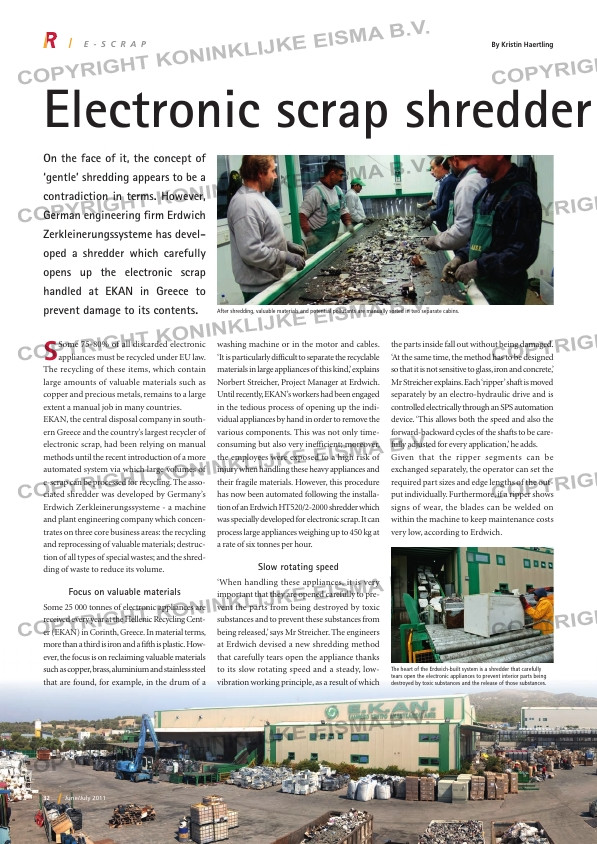Page 32 from: June / July 2011

32 June/July 2011
Electronic scrap shredder takes care of business
On the face of it, the concept of
‘gentle’ shredding appears to be a
contradiction in terms. However,
German engineering firm Erdwich
Zerkleinerungssysteme has devel-
oped a shredder which carefully
opens up the electronic scrap
handled at EKAN in Greece to
prevent damage to its contents.
SSome 75-80% of all discarded electronic appliances must be recycled under EU law.
The recycling of these items, which contain
large amounts of valuable materials such as
copper and precious metals, remains to a large
extent a manual job in many countries.
EKAN, the central disposal company in south-
ern Greece and the country’s largest recycler of
electronic scrap, had been relying on manual
methods until the recent introduction of a more
automated system via which large volumes of
e-scrap can be processed for recycling. The asso-
ciated shredder was developed by Germany’s
Erdwich Zerkleinerungssysteme – a machine
and plant engineering company which concen-
trates on three core business areas: the recycling
and reprocessing of valuable materials; destruc-
tion of all types of special wastes; and the shred-
ding of waste to reduce its volume.
Focus on valuable materials
Some 25 000 tonnes of electronic appliances are
received every year at the Hellenic Recycling Cent-
er (EKAN) in Corinth, Greece. In material terms,
more than a third is iron and a fifth is plastic. How-
ever, the focus is on reclaiming valuable materials
such as copper, brass, aluminium and stainless steel
that are found, for example, in the drum of a
washing machine or in the motor and cables.
‘It is particularly difficult to separate the recyclable
materials in large appliances of this kind,’ explains
Norbert Streicher, Project Manager at Erdwich.
Until recently, EKAN’s workers had been engaged
in the tedious process of opening up the indi-
vidual appliances by hand in order to remove the
various components. This was not only time-
consuming but also very inefficient; moreover,
the employees were exposed to a high risk of
injury when handling these heavy appliances and
their fragile materials. However, this procedure
has now been automated following the installa-
tion of an Erdwich HT520/2-2000 shredder which
was specially developed for electronic scrap. It can
process large appliances weighing up to 450 kg at
a rate of six tonnes per hour.
Slow rotating speed
‘When handling these appliances, it is very
important that they are opened carefully to pre-
vent the parts from being destroyed by toxic
substances and to prevent these substances from
being released,’ says Mr Streicher. The engineers
at Erdwich devised a new shredding method
that carefully tears open the appliance thanks
to its slow rotating speed and a steady, low-
vibration working principle, as a result of which
the parts inside fall out without being damaged.
‘At the same time, the method has to be designed
so that it is not sensitive to glass, iron and concrete,’
Mr Streicher explains. Each ‘ripper’ shaft is moved
separately by an electro-hydraulic drive and is
controlled electrically through an SPS automation
device. ‘This allows both the speed and also the
forward-backward cycles of the shafts to be care-
fully adjusted for every application,’ he adds.
Given that the ripper segments can be
exchanged separately, the operator can set the
required part sizes and edge lengths of the out-
put individually. Furthermore, if a ripper shows
signs of wear, the blades can be welded on
within the machine to keep maintenance costs
very low, according to Erdwich.
E – S C R A P By Kristin Haertling
After shredding, valuable materials and potential pollutants are manually sorted in two separate cabins.
The heart of the Erdwich-built system is a shredder that carefully
tears open the electronic appliances to prevent interior parts being
destroyed by toxic substances and the release of those substances.
03 -s a 3 1 -06-11 10:11



